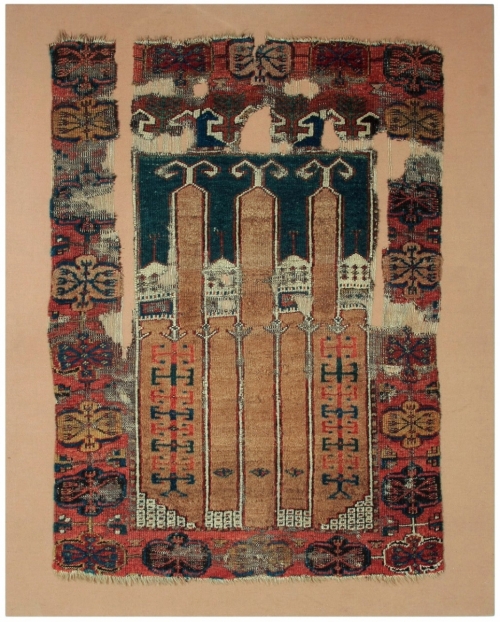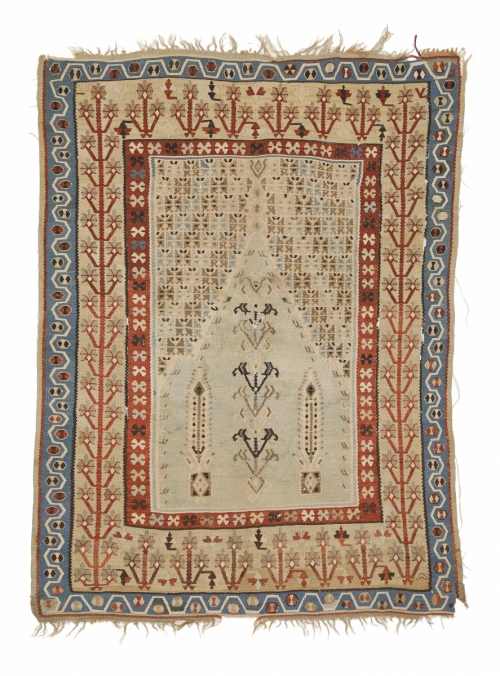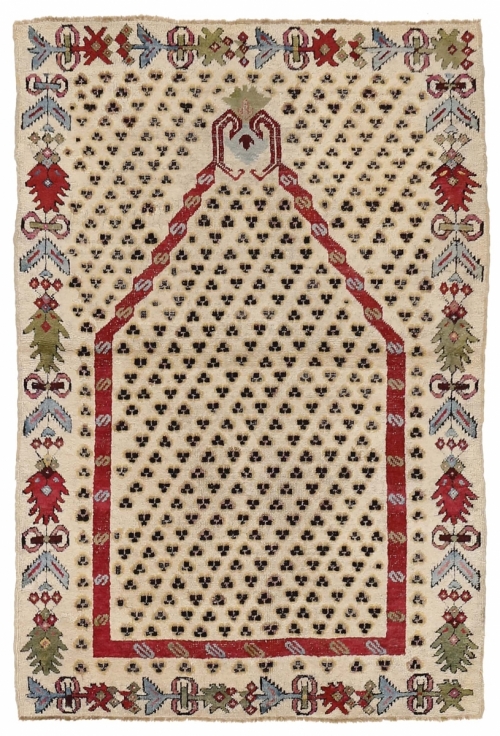 | Green Ground Prayer RugORIGIN Kirsehir,
Central Anatolia SIZE 120 cm x 166 cm
3'11" x 5'5"What I appreciate most of Kirsehir prayer rugs is the audacity in their use of colour. We see such improbable juxtapositions resulting in compositions of impeccable colour balance. Here the calm refinement of the pistachio green niche is probably the perfect harmony to play against of melody of seven lively colours set into spandrels, a top cartouche containing a cloudband element and a plethora of frames. A rug I would imagine a painter would love to depict. - Warp: wool, ivory
- Weft: wool, coral rose, 2 shots between knotted rows
- Knot: symmetrical, weaving direction opposite to niche, moderately depressed warps
- Knot count: 14H x 9V = 126 knots/square inch
- Selvages: flat, two sets of paired warps wrapped with pistachio green wool
- Ends: top and bottom with weft-faced plain weave in pistachio green wool
- Colours: pistachio green, maroon, light yellow, pink, turquoise, brown black, aubergine, ivory (8)
- Condition: pile is medium to low, with areas of wear in the niche; oxidised browns
|
 | Rug with Carnations in NicheORIGIN Kirsehir,
Central Anatolia SIZE 131 cm x 183 cm
4'3" x 6'0"Here we see a slightly different colour combination with respect to the preceding example, yet with that signature spirit of unique colour juxtaposition. The cochineal pink of the niche, which contains a carnation motif we see in the border of Group B Ghiordes prayer rugs, contrasts beautifully with the light green background and is masterfully balanced by the palette of its surroundings. The particularly silky quality of the wool greatly enhances the jewel tonalities of the composition. - Warp: wool, ivory
- Weft: wool, coral rose and rust, 2 shots between knotted rows
- Knot: symmetrical, weaving direction is opposite to niche, no warp depression
- Knot count: 8H x 9V = 72 knots/square inch
- Selvages: flat, two sets of paired warps
- Ends: weft-faced plain weave, top in green and peach stripes and bottom in light rust
- Colours: cherry purple, moss green, rust, medium blue, light blue, light peach, light brown, brown black, aubergine, yellow, ivory (11)
- Condition: pile is very good to medium overall, with oxidised browns; soft, pliable handle
|
 | Mujur Prayer Rug with Apricot BorderSIZE 129 cm x 149 cm
4'2" x 4'10"Ever since I started dealing with rugs I developed a soft spot for Mujur prayer rugs. I have handled a few over the years but nothing that can compare the grandiosity of this example. The rich yet warm red background of the squarish niche (a characteristic which I have found typical of the earliest vintage) is juxtaposed against dark emerald green spandrels, framed by a polychrome tile design border set on apricot. The extreme fineness of weave together with the silky wool pile imparts a particular tactile quality to the piece. The feeling is that of knowing to be in the presence of a majestic rug. - Warp: wool, ivory
- Weft: wool, rust red, 2 shots between knotted rows
- Knot: symmetrical, weaving direction is adjacent to niche, slight warp depression
- Knot count: 9H x 10V = 90 knots/square inch
- Selvages: flat, three sets of paired warps wrapped by pistachio green wool
- Ends: missing
- Colours: mahogany red, forest green, apricot, medium blue, light green, aubergine, brown black, ivory (9)
- Condition: pile is uniformly medium-low, missing slightly at both ends. Some conservation and restorations to selvages. A few scattered knots of old repiling in the niche.
PROVENANCE James Opie Collection, Portland |
 | Teal Green Mujur Prayer RugSIZE 120 cm x 160 cm
3'11" x 5'3"It’s hard to find niche colour variations in Mujur rugs, as most are woven with a characteristic red background, some very rare yellow grounds are known and remains the rarest shade. The beautiful teal background of this example is complemented by a palette of outstanding quality, including an abundant use of aubergine purple. The characteristic tile pattern of the border shows a ‘Crivelli’ type star creating a quincuncial motif that is repeated in countless chromatic combinations. The niche spandrels greatly deviate from the norm, where the ewers are replaced by diagonal sets of squares arranged by colour, appearing almost as fireworks in the distant background of the niche. - Warp: wool, ivory
- Weft: wool, black, 2 shots between knotted rows
- Knot: symmetrical, weaving direction opposite to niche, very slight warp depression
- Knot count: 9H x 9V = 81 knots/square inch
- Selvages: flat, two sets of paired warps wrapped with rust coloured wool
- Ends: missing
- Colours: teal green, mahogany red, medium blue, light blue, turquoise, light yellow, light green, aubergine, dark brown, ivory (10)
- Condition: unrestored; medium pile allover with visible areas of wear and corrosion
|
 | Rug with Flowering Tree in NicheORIGIN Mujur,
Central Anatolia SIZE 118 cm x 173 cm
3'10" x 5'8"As we advance in the nineteenth century the niche tends to become more rectangular and the border more schematic. This corresponds also with a substantial difference in knot counts. Nevertheless Mujur rugs maintain their classical, almost noble posture, with colours distributed in a fairly similar fashion. The flowering tree remains one of the very decors employed by Mujur weavers in their niche lexicon. Interestingly, the direction of weaving follows the direction of the pattern here, differently from the previous two prayer rugs. - Warp: wool, ivory
- Weft: wool, clusters of various colours, 2 shots after knotted rows
- Knot: symmetrical, weaving direction is adjacent to niche, no warp depression
- Knot count: 5H x 6V = 30 knots/square inch
- Selvages: flat, four sets of paired warps
- Ends: brick red weft-faced plain weave
- Colours: brick red, medium blue, moss green, aubergine, light orange, bronze, brown black,
ivory (8) - Condition: pile is uniformly low to knot collars; minor repairs.
|
 | Rug with Opposing Coupled Column NichesORIGIN Konya,
Central Anatolia SIZE 193 cm x 265 cm
6'4" x 8'8"When I first saw this rug opened on the parterre of the Motel Capri in San Francisco I thought I was having visions. I don’t remember ever seeing this niche configuration before. Clearly not intended as a communal prayer rug, as both worshippers would be praying towards each other, it must have otherwise been commissioned for a special occasion as the large format is unique as well for this period. The generously spaced ivory border displays a geometric meander motif, complete of corner solutions, which testifies to the great age of the rug, linking it to earliest manifestations of Anatolian weaving. - Warp: wool, ivory
- Weft: wool, tan, 2-3 shots between knotted rows
- Knot: symmetrical, no warp depression
- Knot count: 5H x 6V = 30 knots/square inch
- Selvages: missing
- Ends: missing
- Colours: light red, teal green, medium blue, light yellow, mustard yellow, dark aubergine, dark brown, ivory (8)
- Condition: small areas of old conservation although basically unrestored, visible areas of wear with associated holes; sides and ends are stabilised, the central section is conserved with light grey cotton backing
|
 | Tripartite Niche Rug with Coupled ColumnsORIGIN Konya,
Central Anatolia SIZE 116 cm x 150 cm
3'9" x 4'11"The triple arches, with one in the centre being highest, are resulting from the background of the main architectural element, supported here by two pairs of coupled columns. Within this ivory element we see a pair of aubergine animal tree columns coalescing into a niche form flanked by ewers, the field being punctuated by a spray of polychrome dots. These randomly arranged dots embellish also the yellow ground border, looking like colourful confetti. A very fine rug with an outstanding sense of balance, expertly woven by an artist whose illegible signature is inscribed at the top of the central niche. - Warp: wool, ivory
- Weft: light yellow, 2 shots between knotted rows
- Knot: symmetrical, weaving direction is opposite to niche, no warp depression
- Knot count: 8H x 10V = 80 knots/square inch
- Selvages: flat, two sets of paired warps wrapped with rust red wool
- Ends: top and bottom with weft-faced plain weave in rust red wool
- Colours: light red, coral pink, yellow, light blue, green, peach, brown black, aubergine, turquoise, ivory (10)
- Condition: pile is uniformly low to knot collars, with partly oxidised browns
|
 | Niche Rug with Four Coupled ColumnsORIGIN Karapinar,
Central Anatolia SIZE 105 cm x 146 cm
3'5" x 4'9"Here four pairs of coupled columns support four small mosque-like architectural forms, against an emerald green perspective; the contrast with the camel background adds greatly to the three-dimensionality of the composition. Early Turkish prayer rugs best display the ‘window over the infinite’ imagery, skilfully highlighting its spiritual monumentality. - Warp: wool, ivory
- Weft: wool, dark brown, 2-3 shots between knotted rows
- Knot: symmetrical, weaving direction adjacent to niche, no warp depression
- Knot count: 6H x 8V = 48 knots/square inch
- Selvages: missing
- Ends: missing
- Colours: camel, dark blue, light yellow, dark green, light red, maroon, dark brown, ivory (8)
- Condition: unrestored; conserved on a beige cotton backing and mounted on a wooden stretcher.
PUBLISHED E. Concaro, A. Levi ‘Sovrani Tappeti - Il tappeto orientale dal XV al XIX secolo’, Milano 1999, plate 22, p. 46 |
 | Rug with curved nicheSIZE 112 cm x 189 cm
3'8" x 6'2"A rug that speaks a primal lexicon, beginning from the unusual shape of the top of the niche and continuing with the syncopated rhythm of the field, sparsely decorated with randomly arranged motifs. Even the border looks peculiar, with the sawtooth leafs appearing as if suspended in air by the absence of the ever present calyx motif. The palette here is particularly pleasing, and paint a picture of an ancient, uncontaminated nature that I find myself yearning. - Warp: wool, ivory
- Weft: wool, light pink-tan, 2-3 shots between knotted rows
- Knot: symmetrical, weaving direction is adjacent to niche, no warp depression
- Knot count: 4H x 5V = 20 knots/square inch
- Selvages: flat, two sets of paired warps
- Ends: top with remnants of red and ivory striped warp-faced plain weave
- Colours: coral red, turquoise green, light blue, copper orange, dark brown, ivory (6)
- Condition: unrestored; conserved on a dark brown cotton backing
|
 | Ivory Çeki Tulu Niche Design RugORIGIN Karapinar,
Central Anatolia SIZE 103 cm x 143 cm
3'4" x 4'8"This archaic looking niche design rug is distinguished by the extra weft loop pile technique, which is one of the earliest forms of weaving that preceded the creation of the pile rug. The dark brown wool defines the direction of weaving as well as the niche itself, reduced here to its basic elements. Its simplification is reminiscent of the elibelinde motif as it appears on central Anatolian kilims, and is of clear Neolithic memory. The use of metallic thread adds a touch of preciousness to the composition, placed as a round motif at the heart of the niche, probably as a protective amulet. - Warp: wool, ivory
- Weft: wool, ivory, three shots between loop pile knotted rows
- Knot: 1/1 extra-weft loop pile on wool balanced plain weave ground
- Selvages: flat, one set of paired warps
- Ends: top end with corded fringes and teased tassels, bottom in balanced plain weave
- Colours: ivory, dark brown, orange, red, light yellow, faded lilac (6)
- Condition: unrestored; a few visible holes and missing sections; some stains on the back
PROVENANCE Mike Aykbarak Collection, Istanbul |
 | Red Ilme Tulu Niche Design RugORIGIN Karapinar,
Central Anatolia SIZE 98 cm x 143 cm
3'2" x 4'8"The large hooked triangle that dominates the composition of this other Tulu acts as a directional motif delineating the prayer niche, which follows the direction of weaving. It could just as well be meditation element connected to the ancient cults of the Neolithic period, as the large triangle is rendered in such a way as if it was depicting a giant pregnant Goddess. The traces of henna painting on the left border emphasize its ritual significance. - Warp: wool, ivory
- Weft: wool, ivory, 3-12 shots between knotted rows
- Knot: symmetrical, weaving direction adjacent to niche, no warp depression
- Knot count: 5H x 3V = 15 knots/square inch
- Selvages: flat, two sets of paired warps
- Ends: top in orange weft-faced plain weave with macrame fringes, bottom with single twined weft
- Colours: maroon, candy pink, lilac, sage green, copper orange (5)
- Condition: very good, with slightly lower pile within the center, suggesting its use as prayer mat
PROVENANCE Husayn Kaplan Collection, Konya |
 | Tulu Prayer RugORIGIN Karapinar,
Central Anatolia SIZE 110 cm x 165 cm
3'7" x 5'5"The overall composition of this niche design rug relates it to a group of white ground central Anatolian prayer rugs, mostly woven with more traditional motifs. The primitive nature of the drawing imparts here a cave-like appearance to the niche. The use of silky Angora mohair wool (filik in Turkish) is characteristic of the most precious Tulus. - Warp: wool, ivory
- Weft: wool, ivory, 3-6 shots between knotted rows
- Knot: symmetrical, weaving direction adjacent to niche, no warp depression
- Knot count: 4H x 3V = 12 knots/square inch
- Selvages: three sets of paired warps
- Ends: weft-faced plain weave; top with corded fringes
- Colours: ivory, maroon (corrosive), light green, red, grey blue, camel, orange (7)
- Condition: very good, in full pile with the exception of some oxidised maroons
|
 | Yatak with Stepped NichesORIGIN Cappadocia,
East Central Anatolia SIZE 140 cm x 202 cm
4'7" x 6'7"I have always been in awe of this rug. It has a very deep soul and at the same time it’s full of joy and hope. Watching the rainbow as my eye reaches the top of the stacked niches of varying widths is an experience that taught me a lot about Anatolian colour. The three fork shaped elements that embellish the narrower niches feel both archaic and humorous. The eye motifs that punctuate the ever changing colours of the background gently transport us to an other-worldly dimension. - Warp: wool, ivory
- Weft: wool, beige, dark brown and pink, 4-8 shots between knotted rows.
- Knot: symmetrical, weaving direction is adjacent to niches, no warp depression
- Knot count: 4H x 3V = 12 knots/square inch
- Selvages: missing
- Ends: missing
- Colours: ivory, light blue, brown, aquamarine, light rose, coral, cochineal red (7)
- Condition: unrestored; conserved on a beige cotton backing
PROVENANCE Marcuson, Hall and Muse, London; Gail Martin Collection, New York. |
 | Erzurum Prayer Kilim in Wool, Cotton and Metal ThreadSIZE 120 cm x 170 cm
3'11" x 5'6"This acquisition is the latest both timewise as well as in terms of placement. It’s also the only flatwoven prayer rug, its presence being amply justified by its refined texture composed of a niche entirely worked in extremely fine cotton, metal thread and only minor touches of wool, the later being predominant in the carnation pattern of the border. The very light denim blue of the cotton background contrasts exquisitely with the ivory and metal thread of the tree elements, giving the peaceful impression of exiting an house of prayer at dusk, after having performed a deep, inner meditation. - Warp: wool, ivory
- Weft: wool, cotton and metallic thread
- Technique: slit tapestry. Some eccentric interlaced outlining.
- Selvages: eight sets of paired warps
- Ends: fringes tied in overhand knots at both ends
- Colours: ivory, light aqua blue, light denim blue (all in cotton), sage green, medium blue, brick red, dark brown (all in wool), grey brown (metal) (8)
- Condition: unrestored; a few open slits and minor missing sections on the perimeter.
|





































